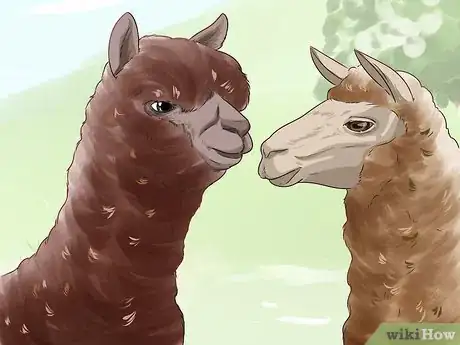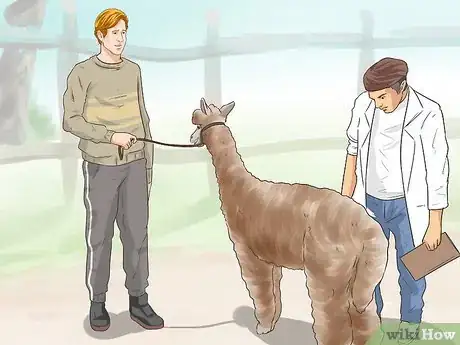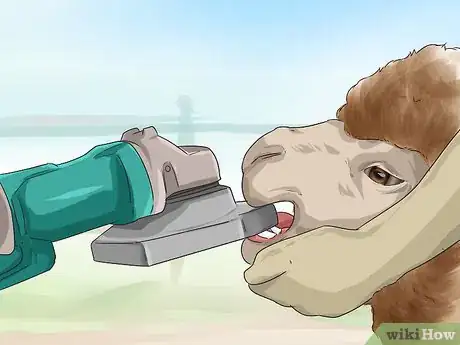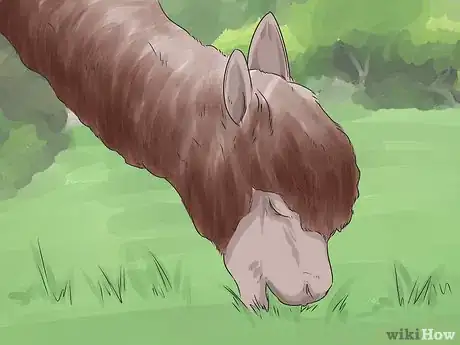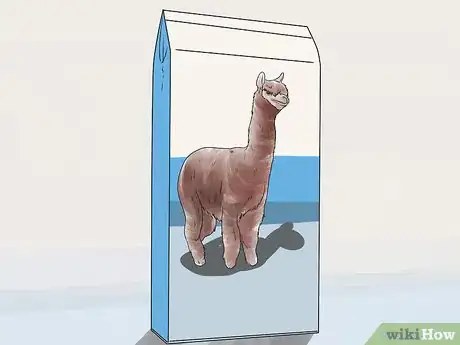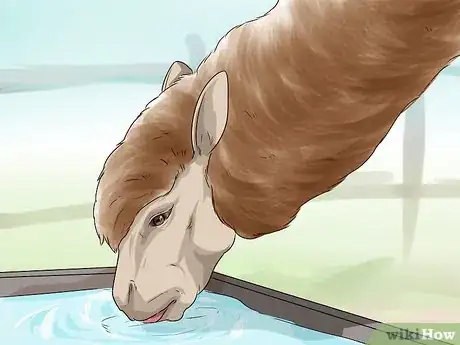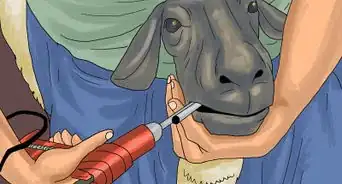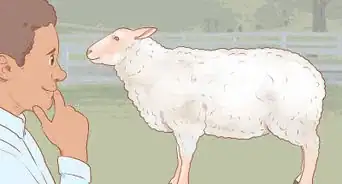This article was co-authored by Ryan Corrigan, LVT, VTS-EVN. Ryan Corrigan is a Licensed Veterinary Technician in California. She received her Bachelor of Science in Veterinary Technology from Purdue University in 2010. She is also a Member of the Academy of Equine Veterinary Nursing Technicians since 2011.
There are 9 references cited in this article, which can be found at the bottom of the page.
wikiHow marks an article as reader-approved once it receives enough positive feedback. In this case, 91% of readers who voted found the article helpful, earning it our reader-approved status.
This article has been viewed 77,546 times.
Llamas are domesticated herd animals indigenous to the highlands of South America. Traditionally, they have been used as beasts of burden, however, many individuals value llama wool for its softness. As a result llamas have become commercially more common in North America and Europe. If you purchase a llama, you will need to understand how to meet its basic needs, feed it and provide it with adequate space and shelter. Once you meet these needs, your llama will be a happy and healthy animal.
Steps
Meeting Your Llama’s Health Needs
-
1Make sure your llama has a companion. Llamas are extremely social creatures and need at least one other llama for its mental well-being. Llamas that are not socialized can be either extremely skittish or abnormally violent and aggressive. The ideal herd size for llamas is four to six animals. Once you have more animals than that, they will begin to split and form new herds. Female llamas in particular have a strong need to form a herd.[1]
- Male llamas can be problematic and disruptive to the herd. If you have a male that is particularly difficult to manage, castration may help calm him down.
- If you cannot afford to purchase a herd of llamas at once, consider buying one llama and then obtaining a rescue llama, which will be much cheaper.
-
2Take your llama to the vet. Once you have purchased your llama, have your veterinarian give it an evaluation. If it has not already received them, your llama will also need its vaccinations. Depending on where you live, you will also likely need to have your llama dewormed at some point. You should also have your veterinarian check the overall health of the animal so that you can better understand what, if any, dietary supplements you need to provide.[2]
- Generally, llamas are hardy animals that do not need much veterinary care. However, it is important that your local vet know your animal in case it ever needs medical attention.
Advertisement -
3Check your llama regularly. You should visit your animal every day to check on its overall health and wellness. Check to see if the animal has any wounds or issues with its fleece. You should also physically check your llama’s body fat every now and then.
-
4Score your llama. Because its fleece can mask its size, you should score you llama regularly. Simply, feel the thickness of the animal’s back at the base of its neck and give a gentle squeeze. If the back is “U”-shaped, the llama is the correct weight. If it is “V”-shaped, your llama is underweight. If it is flat, your llama is overweight.
Grooming Your Llama
-
1Shear your llama regularly. If you have a wooly llama, you will need to shear it at least once, if not twice, a year. Because they have adapted to the cool and moist highlands of South America, a llama’s dense fleece can get too hot in the summer months. You should shear your llama in spring and be sure to leave at least one inch (2.5 cm) of fiber for protection against the elements.[3]
- Classic llamas, as opposed to the wooly variety, do not produce as much wool and should rarely be sheared.
- If you are new to shearing llamas, you should have an experienced shearer show you how it is done. You may also be able to hire someone to do it for you.
- If you shear your llama’s fleece too short, it may get too cold or become sunburned.
- Once sheared, you can sell your llama’s fleece.
-
2Clip your llama's nails . Most llamas will never need to have their toenails trimmed because sufficient exercise will cause then to wear down naturally. However, if your animal comes into contact with a hard surface, they may need a trimming every 2 to 3 months. If your llama does need its nails trimmed, use a pair of large animal nail clippers and make sure that the nails are flush with the bottom of the footpad. [4]
-
3Trim your llama’s teeth if needed. Male llamas develop a set of sharp “fighting” teeth that they use against other males and intruders. You may choose to have your veterinarian remove these teeth to prevent any injury to other animals and yourself. However, if you keep your male away from other males, you may not need to remove the teeth.[5]
- Be sure to talk with your veterinarian about removing your llama’s teeth.
Feeding Your Llama
-
1Let your llamas forage. Llamas are natural foragers that will get most of their nutritional needs met in your pasture. Compared to horses and cattle, llamas are exceptionally efficient eaters and can thrive in a number of pasture types. However, because they are such efficient eaters, they have a tendency to get fat when exposed to particularly healthy pasture land. Score your llama regularly to make sure that it is meeting its nutritional needs through foraging.[6]
- Llamas need a diet that is 10-12 percent protein, so be sure to have your grass and hay tested to make sure you are meeting its needs.
- Try to avoid feeding your llama grain. Llamas are susceptible to choking on it and can easily get fat from grain.
-
2Feed your llamas grass hay. If you live somewhere that has poor quality pasture land or gets regular snow fall, you will want to feed your llama grass hay. Ideally, you should feed your animal orchard grass. You can also feed them alfalfa, but it should never constitute more than 20 percent of its diet. Too much alfalfa can cause a mineral imbalance.
- You should avoid feeding your llama straw, clover and timothy.
- Although it might be a little more costly in the short-term, good quality hay will keep your animal healthy and prevent expensive trips to the veterinarian.
-
3Provide your llamas with mineral supplement. If you have poor pasture land or have to feed your llama hay in the winter, you will likely have to provide a mineral supplement. The best way to do this is to fill a feeder half-full of a commercial llama mineral and place it in the pasture. The llamas will eat the minerals if they need them. You can buy these supplements online or through your local farm supply store.
- Minerals are particularly important for pregnant and lactating female llamas. Without minerals, the females can get sick and possibly die.
-
4Give your llama fresh water. You should provide your llama with a source of fresh drinking water. A stock tank with a freshwater source is ideal. This will need to be high enough to prevent the llamas from getting in the water, but not so high that they cannot drink out of it. If the temperature gets below freezing, you will want to consider purchasing a stock tank heater to prevent ice from forming.[7]
- Do not let your llamas have access to a stream, pond or other water source that they can get in. Llamas love water and will lounge around in it on warmer days. Unfortunately, this can ruin its fleece and result in fungal and bacterial infections on its skin.
Creating a Healthy Habitat
-
1Provide enough space. Before you purchase your llama, make sure that you have the proper amount of pastureland. The general rule of thumb is to have three to four llamas per acre (1/2 hectare). However, if you only have two animals, it does not mean that they only need a half-acre of pasture. You need to make sure that you have enough land to graze your llamas, while the other half remains fallow.
- Consider testing the quality of your pasture grasses before placing llamas on the land.
- Providing enough space for your llama will help keep them happy and healthy. Overcrowding can cause rampant disease.
-
2Create a shelter. In most climates, a three-sided shelter will sufficiently protect your llama. Your animal needs to be warm and dry in the winter, and cool in the summer. Because they are naturally conditioned for cooler climates, a llama may not need a barn since its fleece will help keep it warm. However, if you already have barn, use it.
- Your shelter should be at least seven feet (2 m) tall and wide enough to accommodate multiple llamas.[8]
-
3Build a fence. You will need to construct a fence around your llama, partially to keep it from wandering off, but mostly to keep predators away. Dogs, coyotes and other large animals may attack your llama and injure or kill it. To keep these unwanted animals away, surround your pasture with “no-climb” fence. This sturdy wire fence will keep other animals out and your animal in.[9]
- You will want to purchase no-climb fencing that is at least 4 to 5 feet (1-1.5 m) tall.
- If you already have a wooden fence, simply wrap the no-climb fence around it. This should keep most dangerous animals out.
- You can buy no-climb fence at your local farm supply store.
Expert Q&A
-
QuestionCan you let a llama come in the house with the family?
 Ryan Corrigan, LVT, VTS-EVNRyan Corrigan is a Licensed Veterinary Technician in California. She received her Bachelor of Science in Veterinary Technology from Purdue University in 2010. She is also a Member of the Academy of Equine Veterinary Nursing Technicians since 2011.
Ryan Corrigan, LVT, VTS-EVNRyan Corrigan is a Licensed Veterinary Technician in California. She received her Bachelor of Science in Veterinary Technology from Purdue University in 2010. She is also a Member of the Academy of Equine Veterinary Nursing Technicians since 2011.
Licensed Veterinary Technician Llamas should not go into the house. If the llama gets scared or becomes frightened in an unfamiliar environment it could really hurt itself running around the house and cause extensive damage to your home.
Llamas should not go into the house. If the llama gets scared or becomes frightened in an unfamiliar environment it could really hurt itself running around the house and cause extensive damage to your home. -
QuestionAre safeguard and panacur the same formula?
 Ryan Corrigan, LVT, VTS-EVNRyan Corrigan is a Licensed Veterinary Technician in California. She received her Bachelor of Science in Veterinary Technology from Purdue University in 2010. She is also a Member of the Academy of Equine Veterinary Nursing Technicians since 2011.
Ryan Corrigan, LVT, VTS-EVNRyan Corrigan is a Licensed Veterinary Technician in California. She received her Bachelor of Science in Veterinary Technology from Purdue University in 2010. She is also a Member of the Academy of Equine Veterinary Nursing Technicians since 2011.
Licensed Veterinary Technician Yes, both products contain the drug fenbendazole. However, a panacur power pack is a specific program for horses. Talk to your vet before using either one.
Yes, both products contain the drug fenbendazole. However, a panacur power pack is a specific program for horses. Talk to your vet before using either one. -
QuestionDo llamas live well around other llamas?
 Ryan Corrigan, LVT, VTS-EVNRyan Corrigan is a Licensed Veterinary Technician in California. She received her Bachelor of Science in Veterinary Technology from Purdue University in 2010. She is also a Member of the Academy of Equine Veterinary Nursing Technicians since 2011.
Ryan Corrigan, LVT, VTS-EVNRyan Corrigan is a Licensed Veterinary Technician in California. She received her Bachelor of Science in Veterinary Technology from Purdue University in 2010. She is also a Member of the Academy of Equine Veterinary Nursing Technicians since 2011.
Licensed Veterinary Technician Yes, llamas should live with other llamas because they are herd animals. Llamas can get lonely and develop behavioral problems if they don’t have a herd to be a part of.
Yes, llamas should live with other llamas because they are herd animals. Llamas can get lonely and develop behavioral problems if they don’t have a herd to be a part of.
References
- ↑ http://lostcreekllamas.com/basiccare.htm#anchorcomp
- ↑ http://lostcreekllamas.com/basiccare.htm#anchordeworm
- ↑ https://ag.umass.edu/sites/ag.umass.edu/files/fact-sheets/pdf/Llama%20Shearing%2008-10.pdf
- ↑ http://www.merckvetmanual.com/mvm/exotic_and_laboratory_animals/llamas_and_alpacas/herd_health_of_llamas_and_alpacas.html
- ↑ .http://www.merckvetmanual.com/mvm/exotic_and_laboratory_animals/llamas_and_alpacas/herd_health_of_llamas_and_alpacas.html
- ↑ http://lostcreekllamas.com/basiccare.htm#anchorbf
- ↑ http://lostcreekllamas.com/basiccare.htm#anchorh2o
- ↑ http://lostcreekllamas.com/basiccare.htm#anchorfence
- ↑ http://lostcreekllamas.com/basiccare.htm
